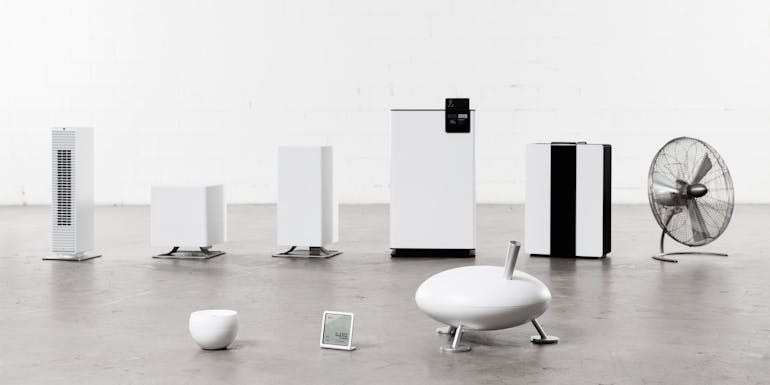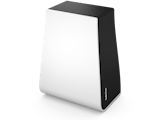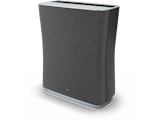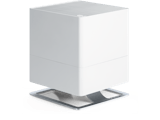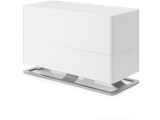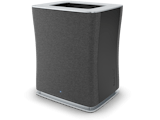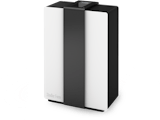Bye bye dry eyes – healthy air in the office
Your throat feels scratchy, your eyes feel dry and fatigue sets in. Many people who work in offices will be familiar with these problems, no matter whether they are employees or supervisors. But only a few will know the reason for these and other symptoms. It’s not always a cold, working too hard or not getting enough sleep that triggers them. Often, it’s a poor quality indoor climate in the office which can put a strain on people’s health and is also likely to affect the mood within the team in the long term. If you know the air quality in the workplace, you can take action if required and use an air humidifier or dehumidifier to improve well-being and productivity.
Signs of poor quality indoor air in everyday office life
Whether you work in an individual or open-plan office in a new or old building, every office has its pitfalls when it comes to creating the ideal indoor climate. The air in new buildings is often too humid because not enough time was spent drying out the foundation walls during the construction process. In old buildings, we can often suffer as a result of significant fluctuations in humidity and temperature according to the season and weather. In open-plan offices, it is necessary to find a happy medium when it comes to the indoor climate in order to satisfy the well-being of the majority as much as possible. In individual offices, we often don’t notice poor quality air at all. There are numerous factors which can influence the quality of the indoor air. Especially in offices where besides the usual sources of air pollution such as humans, animals, fine dust and gases, you also have the heat given off by PCs and the particle emissions from printers. But how can I tell whether my everyday life at the office is being affected by poor air quality?
Illness
In open-plan offices, a lot of employees will fall ill at the same time or go down with something in quick succession. Many people will complain regularly about dry eyes, headaches, itchy contact lenses, dry skin and lips, dandruff, a scratchy throat or frequently get colds.
Performance
Fatigue, sluggishness, an inability to concentrate and a lack of energy are also all signs of poor air quality. And if they are experienced by a lot of people at the same time, then it is definitely time to check the indoor climate.
Visible signs
While it is difficult to detect poor quality air visually, there are indications to suggest that it is present such as the build-up of static electricity on furniture or the significant accumulation of dust shortly after cleaning. Both of these indicate that the air in your office is polluted and dry.
Have you experienced any or all of the above in your office? Then it’s high time you started using a
hygrometer to measure the humidity and temperature.
The optimum indoor climate for the office
Besides regular ventilation (if possible), a pleasant temperature and the right humidity help to create a healthy indoor climate. We all have our own individual sensory perceptions. That is what makes it so difficult to find the «ideal» temperature for everyone in open-plan offices. The State Secretariat for Economic Affairs (SECO) in Switzerland recommends 21–23 °C for cold days and 23–26 °C on summer days*.
The perception of temperature in particular can vary greatly from person to person. We recommend choosing a temperature which suits the majority and looking for an individual solution for everyone else. For instance, a tabletop fan can be set up to cool down people who feel the heat and a small fan heater can be positioned under a desk to provide heat for people who get cold easily.
The perception of humidity is also something that can vary from one person to the next. Experts recommend values which are perceived as pleasant by the majority of people. The recommended relative humidity lies between 40 and 60%. You can measure this using a
hygrometer. If the value regularly exceeds 60%, you need a
dehumidifier. If your hygrometer indicates a value of less than 40% over a period of several days, then it’s high time you got a
humidifier.
Whether at home or in the office, if the measured values indoors deviate from the recommended values over a period of several days, a lot of people may begin to suffer as a result and their experiences can range from mild symptoms to serious illness. If you want to promote health and improve people’s performance and ability to concentrate, you will need to take action.
What should you pay attention to in summer?
It can often get very humid outside in summer as warm air is able to absorb more moisture. That moisture can then also end up indoors. However, the first thing that you should take into account on hot days during the year is whether or not an office has air-conditioning.
If there is no air-conditioning…
… ventilate the office early in the morning and then lower the roller blinds. This will keep the office cool for a long time. An
air purifier can provide clean air throughout the day, allowing you to reduce the level of ventilation accordingly and keep out the warm air from outside. This will stop employees starting to sweat so quickly and enable them to concentrate and remain productive for longer. Anyone who feels the heat can get themselves a
tabletop fan to cool themselves down. In summer, humidity can often present a bigger problem as it promotes the formation of mould which can be dangerous for people and furniture. If conditions remain very humid for a long period of time (> 60%), an air dehumidifier like
Albert or
Theo – according to the size of the room – can remedy the situation.
If there is air-conditioning…
… this type of system will cool the air artificially and extract the moisture from it. Often, the air will become too cold and too dry which can take its toll on the body. Your mucous membranes can dry out, as well as your skin – perfect conditions for cold viruses and ideal prerequisites for headaches and other symptoms. That is when it is particularly worthwhile measuring the humidity, as often it can be so low that you will need to purchase an air humidifier suitable for the size of the room in order to enable employees to perform efficiently.
What should you pay attention to in winter?
If the air outside is cold, it will contain less moisture and as a result, the air is naturally drier in winter. Indoors, central heating can also dry out the air. So the difference between the indoor and outdoor air can vary considerably and it can become even drier indoors than it is outdoors. Neither does the heat from PCs, printers and other electronic devices help the air which is dry already.
The effects that this can have on the body include flaky and cracked skin, dry eyes, dry nasal and pharyngeal mucous membranes, irritation, discomfort and increased susceptibility to respiratory diseases.
During the flu season in particular, dry office air is ideal for promoting the spread of viruses. The low humidity promotes the spread of flu viruses (influenza) and increases the risk of infection. Open-plan offices are often particularly heavily affected by flu outbreaks as the dry air enables viruses to spread quickly and easily. The peak season for these is between December and March.
Increasing the humidity to 40–60% will inhibit the spread of viruses considerably. The moisture in the air binds viruses and bacteria so that they sink to the ground quicker. It will also improve well-being and thus the productivity and performance of employees. So the solution to choose is a humidifier suitable for the size of your room. Why not choose one of the three devices from the Oskar family which are part of our range?
Oskar little is designed for rooms of up to 30 m
2,
Oskar for rooms of up to 50 m
2 and
Oskar big for rooms of up to 100 m
2. If the office air is also polluted by an office dog or there is a main road outside, then an
air washer can also provide a good alternative solution. Air washers are 2-in-1 devices: they are both air purifiers and humidifiers at the same time. There are countless designs and models to choose from. Within our range, you will find
George and
Robert. George is a more powerful purifier than Robert who delivers a slightly better performance when it comes to humidification.
What is important to note with regard to minimum energy buildings (passive houses) with controlled ventilation is that controlled ventilation systems work in the same way as open windows and ensure the constant exchange of air. The result: extremely dry indoor air in winter. That is why we recommend that you choose more powerful humidifiers for ventilated rooms and calculate double the room size compared to non-ventilated rooms (e.g. Oskar for non-ventilated rooms of up to 50 m2 and for ventilated rooms of up to 25 m2).
You will be spoilt for choice! However, the first thing that you need to do is identify the indoor air quality and take the right action. That is the only way to ensure health, well-being and the performance that these enable in the workplace.
If you have questions related to indoor room climate, please get in touch with us. Or subscribe to our newsletter to regularly get informed about current topics regarding indoor climate, experience reports or Stadler Form insights.




